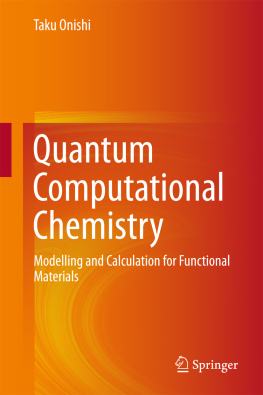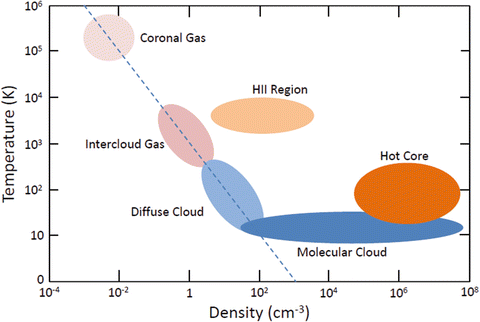1.1 Matter in Space
According to recent cosmological observations (Hinshaw et al. ), 95.4 % of the total mass of the Universe is composed of dark energy and dark matter, and the contribution of baryons (comprising atoms and molecules, familiar to all) is only 4.6 %. Nevertheless, the existence of this small baryonic fraction enables structures such as galaxies, stars, and planets to form. Likewise, it is well known that 98 % of the total mass of baryons is composed of hydrogen (H) and helium (He), whereas the total contribution of heavy elements such as carbon (C), nitrogen (N), and oxygen (O) is only about 2 %. However, the presence of this smaller fraction of heavy elements makes possible the enormous variety of compounds creating the rich chemical world of materials around us.
In astronomy, exploring structure formation and physical evolution processes is a fundamental task in understanding the history of the Universe. For instance, the formation of the first stars, the formation of galaxies, and the formation of stars and planets in galaxies are all currently outstanding topics, and a significant amount of research is being conducted to understand the detailed processes involved during formation and evolution. At the same time, exploring the chemical evolution of matter in the Universe is also a fundamental goal of astronomy. One important aspect of this evolution is nucleosynthesis in stars. Although only H, deuterium (D), He, and a small amount of lithium (Li) were produced in the Big Bang, heavy elements have been produced in stars little by little over the long history of the Universe (1.381010 yr). Synthesized heavy elements in stars are distributed into the interstellar medium in supernova explosions and mass-loss processes of late-type stars. Increasing abundances of heavy elements significantly affect the physical process of star formation by increasing the cooling rate of interstellar gas. A more important and interesting aspect of the evolution of matter is molecular evolution, which is particularly important in relation to understanding star and planet formation and eventually the origin of the Solar System. How are various molecules formed in interstellar clouds? How large can molecules grow in these clouds? How are molecules incorporated into stars and planets? These questions represent current frontiers in astronomy. Studies of structure formation processes and chemical evolution processes of matter are apparently two halves of a whole toward a comprehensive understanding of the history of the Universe.
1.2 Interstellar Matter and Its Circulation
In our Galaxy (the Milky Way), about 90 % of the baryon mass resides in stars, and the remaining is in interstellar matter. Because the total mass of the Galaxy is of the order of 1011 M , the total mass of interstellar matter is about 1010 M . Interstellar matter consists of gas and dust particles; the latter are composed of silicate and carbonaceous compounds, with sizes typically about 0.1 m in diameter. Gas dominates by mass, and the dust-to-gas mass ratio is about 0.01 in the solar neighborhood. Because this ratio depends on metallicitythe abundance of heavy elementsit varies among galaxies and even within our Galaxy.
Elemental abundances in interstellar matter near the solar neighborhood are listed in Table as number ratios relative to hydrogen nuclei. Hydrogen is the most abundant element in the Universe, and helium is the second most abundant. Second raw elements such as C, N, and O have abundances of 103104 relative to H. Heavier elements generally show lower abundances, and abundance significantly varies within the same raw elements, reflecting the nucleosynthetic processes occurring in stars. In particular, iron (Fe), being the element with the highest binding energy per nucleon, is relatively abundant despite its high mass. The elemental abundances given here do not correspond to abundances in the gas phase. Because heavier elements tend to exist in dust grains, their gas-phase abundances are generally lower.
Table 1.1
Cosmic abundance of elementsa
Element | Relative abundance |
|---|
H | 1.00E 0 |
He | 8.51E-02 |
Li | 1.12E-11 |
Be | 2.40E-11 |
B | 5.01E-10 |
C | 2.69E-03 |
N | 6.76E-05 |
O | 4.90E-04 |
F | 3.63E-08 |
Ne | 8.51E-05 |
Na | 1.74E-06 |
Mg | 3.98E-05 |
Al | 2.82E-06 |
Si | 3.24E-05 |
P | 2.57E-07 |
S | 1.32E-05 |
Cl | 3.16E-07 |
Ar | 2.51E-06 |
K | 1.07E-07 |
Ca | 2.19E-06 |
Sc | 1.41E-09 |
Ti | 8.91E-08 |
V | 8.51E-09 |
Cr | 4.37E-07 |
Mn | 2.69E-07 |
Fe | 3.16E-05 |
aAsplund et al. ()
Interstellar matter is not uniformly distributed over the galaxy, but is rather concentrated in clumps and filaments of various scales, called clouds. Figure shows the density and temperature for some representative classes of clouds. The density and temperature of extended clouds such as diffuse clouds, intercloud gas, coronal gas, and some molecular clouds lie almost on a straight line with constant pressure, indicating that these clouds are in pressure equilibrium. In contrast, the densest parts of molecular clouds are gravitationally contracting and hence deviate from the line of constant pressure. Moreover, H II regions around high-mass stars, where hydrogen mostly exists as H+, are not on the line.
Fig. 1.1
Temperature-density diagram of interstellar clouds. The dashed line indicates the constant-pressure line. The diffuse interstellar medium is in pressure equilibrium
The coronal and intercloud components of the interstellar medium are both diffuse and ionized and are often referred to as hot ionized medium (HIM) and warm ionized medium (WIM), respectively (McKee and Ostriker ). Such media will form diffuse clouds after their protons recombine with electrons. In diffuse clouds, atomic hydrogen and molecular hydrogen coexist. As the temperature decreases and the density increases, the diffuse clouds gradually become opaque to interstellar ultraviolet (UV) radiation, and hydrogen molecules become the dominant form of hydrogen. Such clouds are called molecular clouds. Molecular clouds are the formation sites of new stars. Protostars are formed by the gravitational contraction of molecular cloud cores. In general, molecular clouds harbor rich molecules formed in the gas phase and on dust grains. Protostars further evolve into main-sequence stars, during which time planetary systems are formed.












